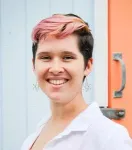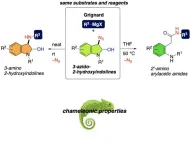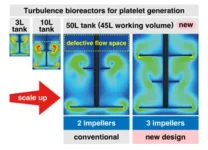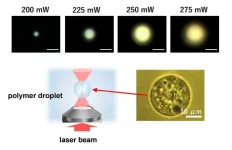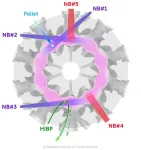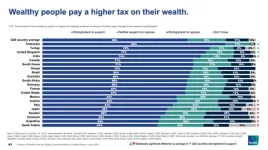(Press-News.org) CHAMPAIGN, Ill. — Scientists have identified a potential driver of aggressive lung cancer tumors in patients who live in areas with high levels of violent crime. Their study found that stress responses differ between those living in neighborhoods with higher and lower levels of violent crime, and between cancerous and healthy tissues in the same individuals.
The findings are detailed in the journal Cancer Research Communications.
The study was designed to address the higher incidence of lung cancer in Black men than in white men, said University of Illinois Urbana-Champaign food science and human nutrition professor Zeynep Madak-Erdogan, who led the research with University of Illinois Chicago School of Public Health health policy and administration professor Sage Kim, the principal investigator of the project. This disparity persists even though, on average, Black men smoke less and start smoking later in life than white men, Kim said.
In another study, Kim and her team found that Black men living in Chicago zip codes with higher violent crime rates had substantially higher levels of hair cortisol — one indicator of chronic stress — than those in areas with less violent crime.
Other studies have linked chronic exposure to stress to poorer outcomes in cancer patients, Madak-Erdogan said. But scientists’ understanding of how stress “gets under the skin” to influence lung cancer prognosis is limited.
The newer analysis focused on glucocorticoids, a group of steroid hormones like cortisol.
These hormones bind to receptors that regulate the activity of other genes. Glucocorticoids and their receptors are involved in a variety of key functions, Madak-Erdogan said. They help regulate fetal and newborn lung tissue development, and play a role in metabolism, homeostasis, inflammation and immune function in this tissue.
The researchers first assessed patterns of gene expression in lung cancer tumors and in cancer-free lung tissue from patients who lived in various Chicago zip codes — some with higher or lower levels of violent crime. The team also determined where the glucocorticoid receptors were binding on DNA in those tissues.
Both analyses revealed that GR binding and gene-expression patterns were different in healthy versus tumor tissues, and that the patterns also differed by a patient’s zip code. Overall, GR binding was highest in people who lived in high-violence areas. But within the tumor tissues, those living in high-crime zip codes had lower GR binding. They also had lower levels of GR-regulated genes in the tumor tissues.
The analyses also revealed that, within tumors, the GRs were activating genes for enzymes that degrade cortisol. This accounted for the lower cortisol levels — thus lower GR binding — in the tumors than in normal lung tissue. The lower cortisol levels were likely influencing the overall behavior of the receptors in the lung cancer tumors, Madak-Erdogan said.
“In terms of the genes the receptors regulated in the tumors of individuals living in high-violence areas, they were genes related to inflammation, higher proliferation, higher growth-factor signaling, all of which will lead to the worst outcomes for lung cancer,” she said. “While we didn’t prove a direct relationship in this study, our findings suggest that glucocorticoids and glucocorticoid receptors are a main driver of adverse tumor outcomes in patients living with chronically high levels of environmental stress.”
The study accounted for other factors, such as environmental risk and poverty, that might lead to worse health outcomes in people living in high-crime areas, Kim said. It found no consistent correlation between poverty or environmental risk and lung cancer in the neighborhoods of interest.
Prior to the new study, scientists suspected that stress hormones played a role in cancer or other health disparities, Madak-Erdogan said. “But we didn’t know the exact role they play, or how they work to drive lung cancer progression. I think this study really crystallizes the idea that it’s not just that individuals in these areas are more stressed. It’s also that their stress responses are dysregulated. There is a direct effect of these hormones on the normal cellular physiology.”
Madak-Erdogan is a professor in the Carl R. Woese Institute for Genomic Biology and the National Center for Supercomputing Applications at the U. of I. She also is the associate director for education in the Cancer Center at Illinois. U. of I. graduate student Hannah Heath is the first author of the paper.
The National Institute of Minority Health and Health Disparities at the National Institutes of Health supported this research.
Editor’s notes:
To reach Zeynep Madak-Erdogan, email zmadake@illinois.edu.
To reach Sage Kim, email skim49@uic.edu.
The paper “The effect of exposure to neighborhood violence on glucocorticoid receptor signaling in lung tumors” is available from the U. of I. News Bureau.
Cancer Research Communications is a journal of the American Association for Cancer Research.
END
PHILADELPHIA, June 24, 2024 — About 80% of an individual’s modifiable health contributors are determined by social and economic factors.[1] Exposure to violence can have detrimental health implications contributing to toxic stress and trauma, mental health illness, substance abuse and an increased risk for heart disease[2].
The American Heart Association, which marked 100 years of service saving lives earlier this month, has distributed $480,000 from the Association’s Bernard J. Tyson Impact Fund to four social ...
Aniline or nitrogen-containing organic molecules like 3-aniline-substituted indoles commonly found in natural products have shown promising results as pharmaceutical contenders. The same goes for moieties such as 2-aminoaryl acetic acid scaffold which forms the fundamental structural motif of nonsteroidal anti-inflammatory drugs such as diclofenac which inhibits COX-2 to relieve pain and inflammation. While there are several ways of synthesizing these molecules individually using different starting materials, can we produce them ...
It’s summer and time to enjoy the sunshine. But it’s also important to do so safely. Skin cancer is the most common form of cancer in the United States—and it’s most commonly caused by sun exposure. Research has shown that skin self-awareness and regular skin self-examinations are strongly linked to better treatment outcomes if you receive a skin cancer diagnosis.
As part of an effort to identify effective interventions to increase skin self-examinations and decrease melanoma deaths, faculty ...
University of Texas at Dallas researchers have developed an artificial intelligence (AI) model that could help electrical grids prevent power outages by automatically rerouting electricity in milliseconds.
The UT Dallas researchers, who collaborated with engineers at the University at Buffalo in New York, demonstrated the automated system in a study published online June 4 in Nature Communications.
The approach is an early example of “self-healing grid” technology, which uses AI to detect and repair problems such as outages ...
Artificial intelligence (AI) is accelerating the development of new materials. A prerequisite for AI in materials research is large-scale use and exchange of data on materials, which is facilitated by a broad international standard. A major international collaboration now presents an extended version of the OPTIMADE standard.
New technologies in areas such as energy and sustainability involving for example batteries, solar cells, LED lighting and biodegradable materials require new materials. Many researchers around the world are working to create materials that have not existed before. But there are major challenges in creating materials ...
iPS cell-derived expandable immortalized megakaryocyte progenitor cell lines (imMKCLs) represent a renewable means to produce large amounts of platelets ex vivo for transfusion. Despite generating 100 billion (1011) competent iPS cell-derived platelets using a 10-L tank system previously by recreating turbulent flow with optimal turbulent energy and shear stress, true industrial-scale manufacturing is necessary for a consistent supply of transfusable platelets for patients with thrombocytopenia and other platelet disorders. As such, the team began this study by developing a 50 L good manufacturing practices (GMP) grade, single-use United States Pharmacopoeia ...
In a pooled analysis of three clinical trials, acupuncture significantly reduced hot flashes and other hormonal side effects of endocrine therapy taken by women with breast cancer. The analysis of data from the United States, China, and South Korea is published by Wiley online in CANCER, a peer-reviewed journal of the American Cancer Society.
Endocrine therapy, which blocks hormone signaling that drives some forms of breast cancer, can be a life-saving treatment, but up to 80% of patients who take it experience hot flashes—a ...
A novel technique with potential applications for fields such as droplet chemistry and photochemistry has been demonstrated by an Osaka Metropolitan University-led research group.
Professor Yasuyuki Tsuboi of the Graduate School of Science and the team investigated Förster resonance energy transfer (FRET), a phenomenon seen in photosynthesis and other natural processes where a donor molecule in an excited state transfers energy to an acceptor molecule.
Using dyes to mark the donor and acceptor molecules, the team set out to see if FRET could be controlled by the intensity of an optical force, in this case a laser beam. By focusing a laser beam on an isolated polymer droplet, the team ...
Background
In the realm of fusion research, the control of plasma density, temperature, and heating is crucial for enhancing reactor performance. Effective confinement of plasma particles and heat, especially maintaining high density and temperature at the core where fusion occurs is essential. In the Large Helical Device (LHD)*1, challenges persist as the electron density profile often remains flat or even depressed at the center, complicating effort to sustain high central density.
Results
The LHD is equipped with five neutral beam (NB) injectors*3 for plasma ...
A new survey of adult citizens in 18 of the world’s largest economies has revealed majority support for tax reforms and broader political and economic reform. (Not all questions were asked in China, as indicated when findings reference 17 G20 countries.)
Around two-thirds (68%) of citizens across 17[1] G20 countries surveyed back a wealth tax on wealthy people as a means of funding major changes to our economy and lifestyle, with only 11% opposed, while 70% support higher rates of income tax on wealthy people, and 69% favour higher tax rates on large businesses, according to the survey conducted by Ipsos.
Support for a wealth tax on ...


